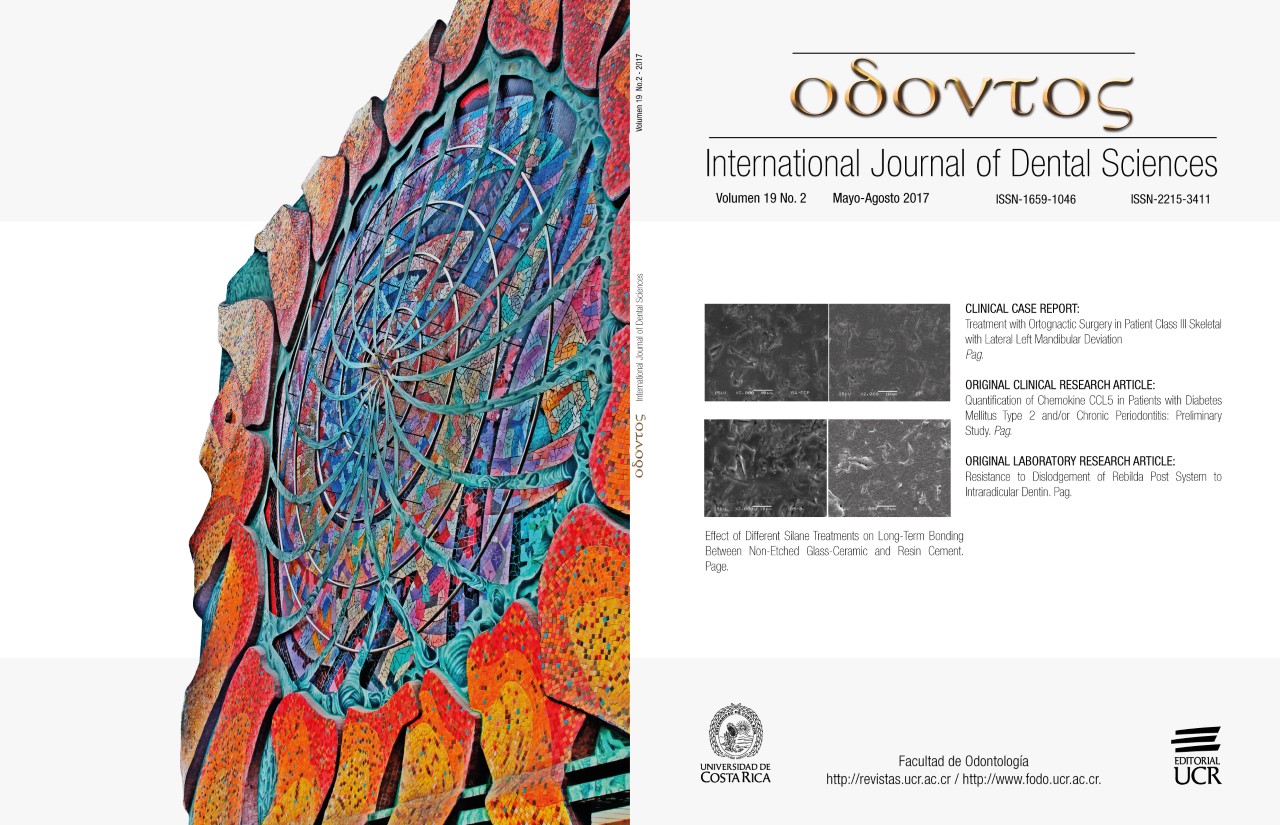Abstract
Currently there is controversy in the literature about clinical and adhesive effectiveness with respect to adhesive systems aimed to root reinforcement. Thus, the objective of this study was to evaluate the Push-Out bond strength between the Rebilda® post system and the intraradicular dentine. Thus, 28 unirradicular teeth were used, cut and standardized in 16 mm. The root segments were submitted to endodontic treatment; and then randomly divided into two groups, Group 1 (n = 14): Rebilda® DC + Futurabond DC; Group 2 (n = 14): RelyX ARC + Adper Scothbond Multipurpose Plus. Ten specimens from each group were submitted to the Push-Out Test. The remaining 4 specimens from each group were prepared for Scanning Electron Microscopy (SEM) in order to evaluate the formation of resinous extensions at the post-cement-dentin interface. Group 2 showed better results when compared to Group 1 regarding bond strength and in formation of resinous extensions or tags, but there was no statistically significant difference (p>0.05). It was concluded that the REBILDA® Post System promotes adequate bond strength to intraradicular dentin.
References
Cagidiaco, M. et al. Mapping of tubule and intertubule surface areas available for bonding in Class V and Class II preparations. Journal of Dentistry. 1997; 25: 379-389.
Cagidiaco, M. et al. Clinical studies of fiber posts: a literature review. International Journal of Prosthodontics. 2008; 21: 328-336.
Ferrari, M. et al. Bonding to root canal: Structural characteristics of the substrate. American Journal of Dentistry. 2000;13: 255-60.
Cardoso, Luiz et al. Push-Out Bond Strength of Quartz Fiber Posts Luted with Self-Adhesive and Conventional Resin Cements. Odovtos - International Journal of Dental Sciences. 2016; 18, (2): 73-90.
Ferrari, M. Fiber posts and endodontically treated teeth: a compendium of scientific and clinical perspectives. Modern Dentistry Media. 2008; 85-93.
Ferrari, M. et al. Influence of luting material fiber content on post cementation. Journal of Dental Research. 2009; 8 (10): 951-956.
Dietschi, D. rt al. Biomechanical considerations for the restoration of endodontically treated teeth: a systematic review of literature. Part II: Evaluation of fatigue behavior, interfaces, and in vitro studies. Quintessence International. 2008; 39: 117-129.
Bouillaguet, S., Troesch, S., Wataha, J., Krejci, I., Meyer, J. & Pashley, D. Microtensile bond strength between adhesive cements and root canal dentin. Dental Materials. 2003; 19: 199-205.
Goracci, C. & Ferrari M. Current perspectives on post systems: a literature review. Australian Dental Journal. 2011; 56: 77-83.
Mjör, I., Smith, M., Ferrari, M. & Mannocci, F. The structure of dentine in the apical region of human teeth. International Endodontic Journal. 2001; 34: 346-353.
Ferrari, M., Vichi, A. & Garcia-Godoy, F. Clinical evaluation of fiber-reinforced epoxy resin posts and cast post and cores. American Journal of Dentistry. 2000; 13: 8b-15b.
Ferrari, M., Vichi, A. & Grandini, S. Efficacy of different adhesive techniques on bonding to root canal walls an SEM investigation. Dental Materials. 2002;(17): 422-429.
Bitter, K. et al. Analysis of Resin-Dentin Interface Morphology and Bond Strength Evaluation of Core Materials for One Stage Post-Endodontic Restorations. Plos One. 2014; 9(2) e86294.
Ferrari, M. et al. Influence of luting material filler content on post cementation. J Dent Res. 2009; 88:951–956.
Radovic I, Mazzitelli, C., Chieffi, N., Ferrari, M. Evaluation of the adhesion of fiber posts cemented using different adhesive approaches. Eur J Oral Sci. 2008; 116: 557–563.
Perdigao, J., Monteiro P, Gomes G, Santos, V. Restoring teeth with prefabricated fiber-reinforced resin posts. Pract Proced Aesthet Dent. 2007; 19: 359–364; quiz 365.
Sterzenbach, G. et al. Fiber post placement with core build-up materials or resin cements-An evaluation of different adhesive approaches. Acta Odontologica Scandinavica. 2012; 70: 368–376.
Perdigao, J., Gomes, G. & Lee, I. The effect of silane on the bond strengths of fiber posts. Dental Materials. 2006; 22(8): 752-758.
Mannocci, F., Ferrari, M., Watson, T. Microleakage of endodontically treated teeth restored with fiber posts and composite cores after cyclic loading: a confocal microscopic study. Journal of Prosthetic Dentistry. 2001; 85: 284-291.
Prisco, D. et al. Fiber post adhesion to resin luting cements in the restoration of endodontically-treated teeth. Operative Dentistry. 2003; 28: 5: 51-521.
Vichi, A., Grandini, S. &Ferrari, M. Comparison between two clinical procedures for bonding fiber posts into a root canal: A microscopic investigation. Journal of Endodontic. 2002;28:5: 355-360.
Vichi, A., Vano, M. &Ferrari, M. The effect of different storage conditions and duration on the fracturestrength of three types of translucent fiber posts. Dental Materials.2008; 24: 832-838.
Ramírez Barrantes DDS, MS, PhD, J., Araujo Jr DDS, MS, PhD, E., & Narciso Baratieri DDS, MS, PhD, L. Clinical Evaluation of Direct Composite Resin Restorations in Fractured Anterior Teeth. Odovtos - International Journal of Dental Sciences. 2015; 0(16), 47-62.
Cardoso, L., Araújo DDS, MSD, PhD, É., Narciso Baratieri DDS,MSD, PhD, L., & Ramírez DDS, MSD, PhD, J. Push-Out Bond Strength of Quartz Fiber Posts Luted with Self-Adhesive and Conventional Resin Cements. Odovtos - International Journal of Dental Sciences, 2016; 18 (2), 73-90.
Arrais, C. et al. Effect of curing mode on microtensile bond strength to dentin of two dual-cured adhesive systems in combination with resin luting cements for indirect restorations. Operative Dentistry. 2007; 32:1: 37-44.
Ferrari, M. et al. Influence of microbrush on efficacy of bonding into root canals. American Journal of Dentistry. 2002; 15:4: 227-231.
Bitter, K. et al. Morphological and bond strength evaluation of different resin cements to root dentin. European Journal of Oral Sciences. 2009; 17:3: 326-333.
Tay, F., Loushine, R., Lambrechts, P., Weller, R. & Pashley, D. Geometric factors affecting dentin bonding in root canals: A theoretical modeling approach. Journal of Endodontics. 2005; 31: 584-589.
Nakabayashi, N., Kojima, K. & Masuhara, E. The promotion of adhesion by the infiltration of monomers into tooth substrates. Journal of Biomedical Materials Research. 1982; 16: 265–9.
Nakabayashi, N. & Pashley, D. Hybridization of dental hard tissue. Quintessence International. 1998; 29: 195-203.
Mannocci, F., Ferrari, M., Watson, T. Microleakage of endodontically treated teeth restored with fiber posts and composite cores after cyclic loading: a confocal microscopic study. Journal of Prosthetic Dentistry. 2001; 85; 284-291.

